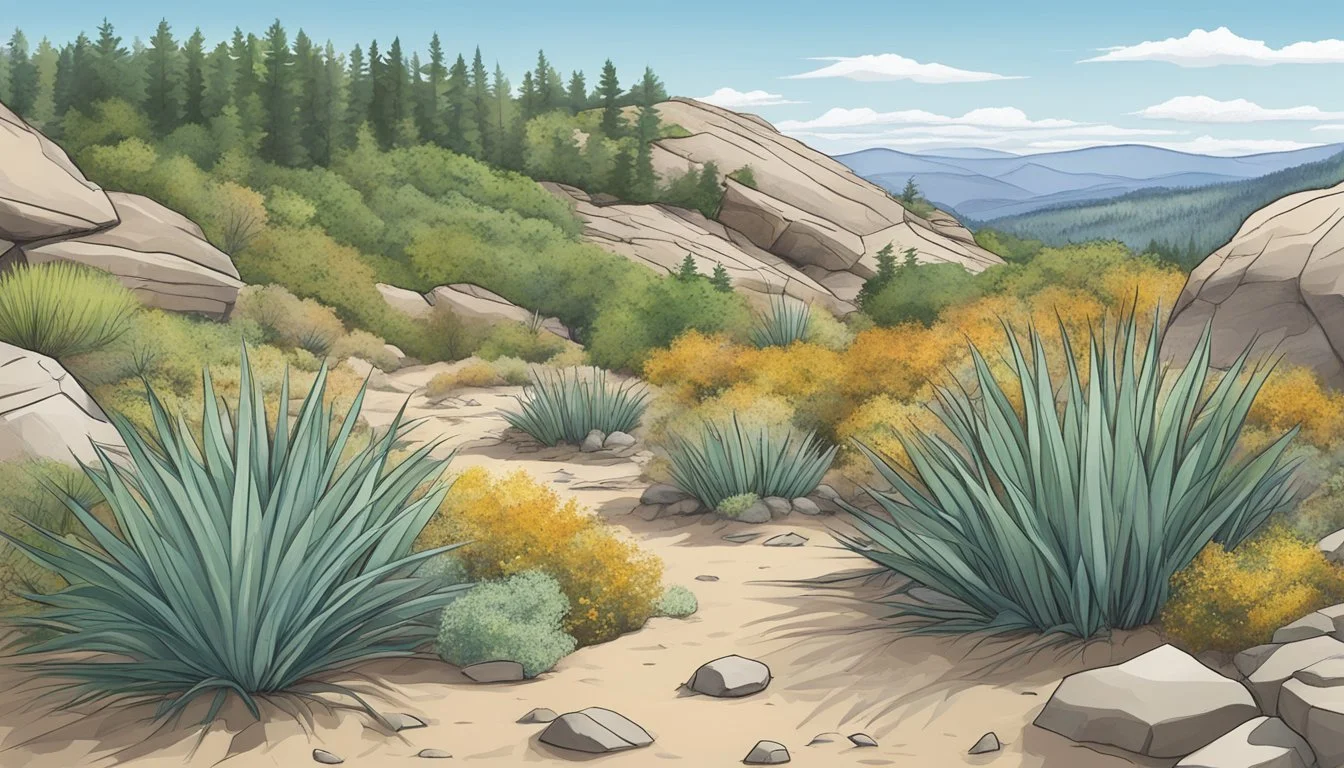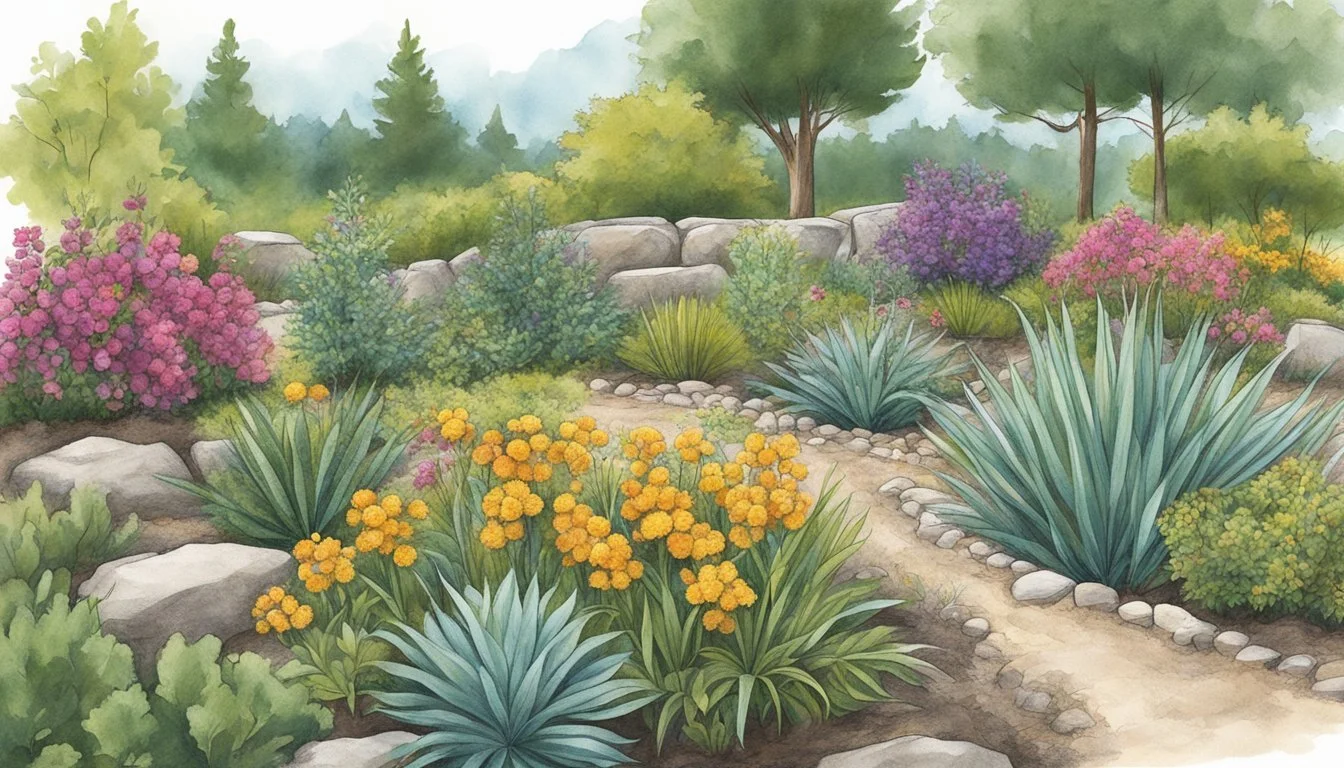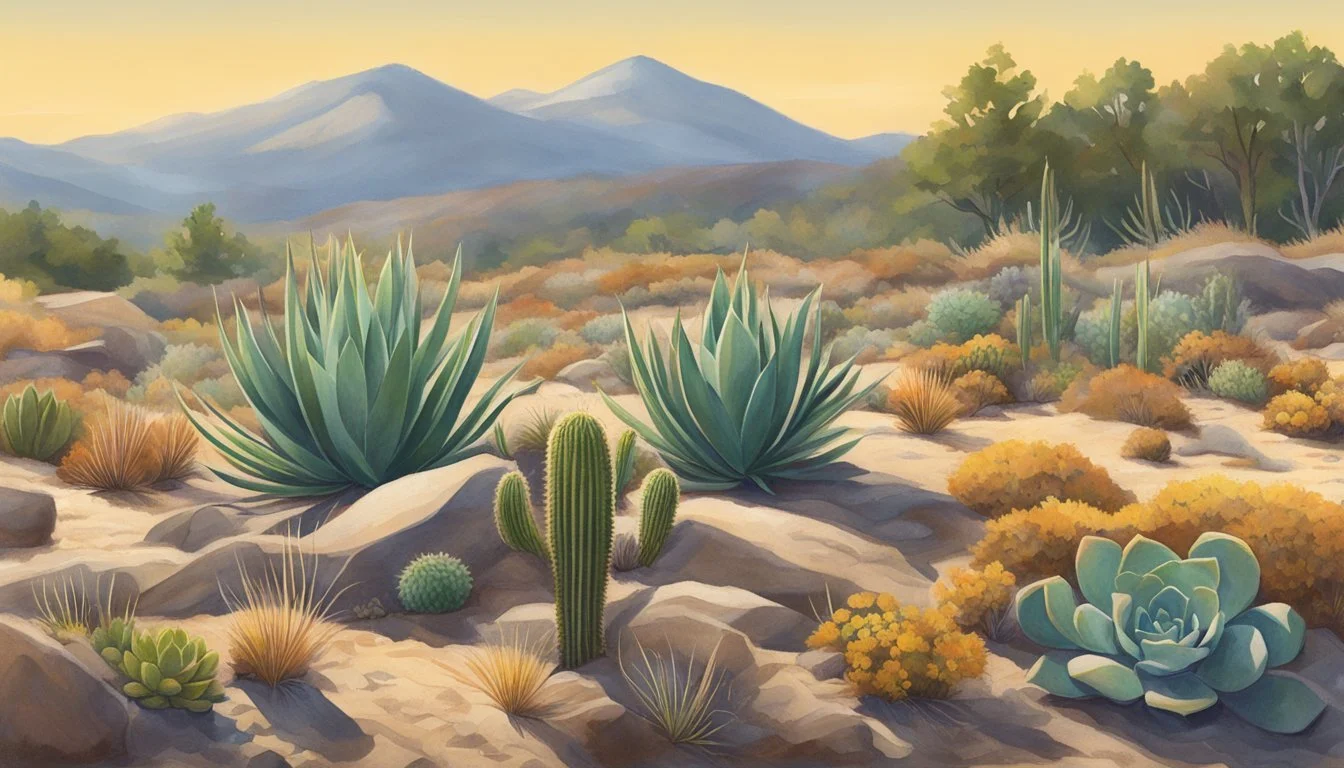Drought-Tolerant Plants in New Hampshire
A Guide to Resilient Gardening
In the varied climate of New Hampshire, where rainfall can fluctuate widely, incorporating drought-tolerant plants into landscapes is a strategic approach to gardening and landscaping. These hardy species thrive on minimal water, making them indispensable for sustainable horticulture practices across the state. From ornamental grasses to flowering perennials, New Hampshire offers a rich palette of plants adapted to withstand periods of low precipitation, ensuring that gardens remain vibrant even during dry spells.
Understanding the importance of selecting plants that can handle sporadic rainfall is crucial for maintaining green spaces in New Hampshire. Some of the most resilient varieties, such as sedum and ornamental grasses, offer aesthetic appeal while being low maintenance. These drought-tolerant species not only conserve water but also contribute to biodiversity, support local ecology, and reduce the need for chemical fertilizers and pesticides. Gardeners and landscapers are thus encouraged to consider these resilient plants as part of their landscape design.
When planning a water-wise garden, it is essential to choose plants that are suited to New Hampshire's climate zones. By selecting adaptable species that are drought-tolerant and cold hardy, one ensures that the landscaping is robust and sustainable. Moreover, proper plant selection can help to mitigate the effects of climate change by fostering landscapes capable of enduring extreme weather patterns. As a result, drought-tolerant landscaping is not just a practical approach for gardeners but a step forward in creating environmentally responsive outdoor spaces.
Understanding Drought and Its Impact on Landscaping
When discussing landscaping under the lens of drought conditions, one must be mindful of the intricate balance between maintaining aesthetic appeal and environmental sustainability. In regions like New Hampshire, the variable climatic conditions add an additional layer of complexity.
Defining Drought and Its Phases
Drought is a period of abnormally low rainfall, leading to a shortage of water. In New Hampshire, drought conditions can be especially impactful due to the region's dependence on consistent rainfall patterns for healthy natural landscapes. The phases of drought begin with a deficiency in precipitation and escalate to a drought emergency, where water restrictions may be enforced. These phases include:
Meteorological Drought: When the region experiences less rainfall than its seasonal average.
Hydrological Drought: Results from prolonged meteorological drought, affecting water supply systems.
Agricultural Drought: Affects crop production and soil moisture levels.
Socioeconomic Drought: When water scarcity impacts the economy and society.
Drought Impact on Natural and Urban Landscapes
The impact of drought on landscapes in New Hampshire is multifaceted. Natural landscapes undergoing periods of above-normal precipitation may thrive initially, but are often followed by intervals of scarcity that can weaken plants' resilience to dry conditions. Urban landscapes, on the other hand, face additional challenges such as heat island effects, which can exacerbate the water deficit.
In response to these challenges, drought-tolerant landscaping has become a pivotal strategy. It involves selecting plants adapted to survive with minimal water, and restructuring landscapes to reduce water consumption and wastage, ensuring longevity and vibrancy even during times of drought. This approach not only preserves the local aesthetic but also aligns with sustainable water management practices amid variable climatic conditions.
Climate Considerations for New Hampshire
New Hampshire's varying topography significantly influences its climate, which is pivotal when selecting drought-tolerant plants suitable for local landscapes.
New Hampshire's Hardiness Zones
New Hampshire spans several USDA hardiness zones, but primarily, parts of the state fall within Zone 3 or Zone 4. These zones indicate regions where temperatures can plummet to -40°F to -20°F and -30°F to -20°F, respectively. Thus, plants chosen for gardens and landscapes need to be cold hardy, capable of withstanding these challenging winter conditions.
Local Rainfall and Weather Patterns
Consistent with its continental climate, New Hampshire experiences rainfall patterns that vary seasonally. Summers can be warm and humid, while winters are generally cold with significant snowfall. Average annual precipitation varies across the state but tends to range from 40 to 50 inches. Selecting plants that can tolerate periods of low rainfall, especially during occasional summer droughts, is essential for sustainable gardening in New Hampshire.
Fundamentals of Drought-Tolerant Landscaping
Incorporating drought-tolerant plants and efficient water management strategies is vital for sustainable landscaping in regions prone to dry conditions. This section outlines the necessary steps and considerations for creating a landscape resilient against water scarcity.
Principles of Xeriscaping
Xeriscaping is a landscaping philosophy that reduces or eliminates the need for supplemental water from irrigation. The practice is built upon seven core principles:
Planning and Design: Begin with a comprehensive design that zones plants according to their water needs.
Plant Selection: Prioritize drought-tolerant plants that are well-adapted to New Hampshire's climate and soil conditions.
Grass Areas: Limit the size of lawn areas with grass that requires frequent watering.
Efficient Irrigation: Utilize drip irrigation or soaker hoses to target water directly to plant roots.
Soil Improvement: Amend soil to improve its ability to retain water and support healthy plant growth.
Use of Mulches: Apply organic or inorganic mulches to retain soil moisture and reduce evaporation.
Maintenance: Regularly maintain the landscape to ensure the health of plants and the efficiency of the irrigation system.
Soil Preparation and Amendments
Proper soil preparation is a cornerstone of drought-tolerant landscaping.
Soil Type: The local soil type in New Hampshire significantly impacts water retention and plant growth. Sandy soils drain quickly but can dry out fast, while clay soils hold moisture longer but may not allow easy root penetration.
Amendments: Integrating organic matter such as compost can greatly increase the soil's water-holding capacity and provide essential nutrients for plant health.
Efficient Irrigation Systems
A strategic approach to irrigation is key to the longevity of a drought-tolerant landscape.
Drip Irrigation: This system delivers water directly to the base of the plant, minimizing water loss due to evaporation or runoff.
Timing: Irrigate during the cooler parts of the day, such as early morning or late evening, to further reduce water loss.
Automation: Employ timers and moisture sensors to provide water to plants only as needed, preventing overwatering and waste.
By considering these specialized strategies in xeriscaping, soil management, and irrigation, one can establish a resilient and water-efficient landscape.
Selecting Drought-Tolerant Plants for New Hampshire
When creating a garden in New Hampshire, choosing plants that can thrive with minimal water is essential. By selecting shrubs, perennials, and other plants suited for drier conditions, gardeners can cultivate a resilient and beautiful landscape.
Shrubs and Deciduous Trees
For a New Hampshire landscape, opting for shrubs and deciduous trees that require less water can help in maintaining a garden during dry spells. Crabapple trees not only withstand drought but add a splash of color with their spring blossoms. Japanese Tree Lilac provides fragrant flowers and is also a hardy choice for dry conditions.
Shrubs:
Barrenwort (Epimedium spp.)
Butterfly Bush (Buddleja davidii)
Hydrangea varieties adapted to less water
Deciduous Trees:
Japanese Tree Lilac (Syringa reticulata)
Crabapple (Malus spp.)
Perennials and Ornamental Grasses
Perennials and ornamental grasses that tolerate drought can provide long-lasting beauty with fewer water needs. Black-eyed Susan (Rudbeckia) and Coneflower (Echinacea) are known for their resilience and vibrant flowers. Sedum and Yarrow offer diverse foliage and flower options that are perfect for New Hampshire’s changing climate.
Perennials:
Black-eyed Susan
Coneflower
Lavender (Lavandula)
Sage (Salvia)
Ornamental Grasses:
Blue Fescue (Festuca glauca)
Maiden Grass (Miscanthus sinensis)
Groundcovers and Vines
Choosing the right groundcovers and vines ensures a lush carpet that keeps soil moisture in and maintenance down. Bearberry (Arctostaphylos uva-ursi) and Comptonia peregrina are excellent drought-tolerant options. Functional and aesthetic, these plants form a dense mat that requires little upkeep once established.
Groundcovers:
Bearberry
Bugleweed (Ajuga reptans)
Dead Nettle (Lamium maculatum)
Vines:
Periwinkle (Vinca minor)
Wild Ginger (Asarum canadense)
Annuals and Succulents
For splashes of color without heavy water requirements, annuals and succulents are the go-to plants. Lantana and Verbena provide brilliant blooms and attract pollinators, while Sedum species are succulents that offer unique textures and are virtually maintenance-free.
Annuals:
Lantana (Lantana camara)
Verbena (Verbena spp.)
Candytuft (Iberis sempervirens)
Succulents:
Sedum (Sedum spp.)
Yucca (Yucca filamentosa)
Cultivation and Care of Drought-Tolerant Species
When establishing drought-tolerant plants in New Hampshire landscapes, careful consideration of watering and maintenance practices ensures these species thrive. Pruning and growth management are equally crucial, fostering resilient plants that can withstand variable weather conditions.
Watering and Maintenance Practices
Initially, drought-tolerant plants require regular watering to establish deep, robust root systems. Once established, they should be watered deeply but infrequently to mimic their natural arid habitats. Proper maintenance includes:
Supplemental watering during extended dry periods, particularly for younger plants
Monitoring soil moisture: Water once the top few inches of soil are dry
Mulching to retain soil moisture and regulate temperature
Pruning and Managing Growth
Pruning is essential for maintaining plant health and encouraging vigorous growth. Guidelines for effective pruning include:
Removing dead or diseased wood during the plant's dormancy period
Cutting back overgrowth to promote air circulation and reduce disease risk
Shaping plants to control size and encourage new growth
Regular maintenance and selective pruning are key to the success of drought-tolerant species in New Hampshire, ensuring they not only survive but flourish with minimal resources.
Designing a Drought-Resistant Landscape
In New Hampshire's varying climate, it's essential to incorporate drought-tolerant plants into the landscape design to maintain a resilient and visually appealing garden.
Garden Design for New Hampshire
Drought-tolerant garden design begins with selecting plants that thrive in New Hampshire’s unique conditions. It involves understanding the local climate, soil type, and the specific needs of each plant. Considering these elements leads to a garden that conserves water without compromising on beauty. For instance, the University of New Hampshire Cooperative Extension provides an extensive list of drought-tolerant plants for New Hampshire landscapes, which can be used to form the backbone of your design. Strategic placement of these plants, ensuring that those with similar water requirements are grouped together, can further enhance water efficiency.
Key Components in Garden Design:
Selection of Plants: Deciduous trees, shrubs, and various perennials selected for their drought tolerance.
Soil Preparation: Amending the soil to improve its water retention capabilities.
Water Conservation: Utilizing mulch to reduce water evaporation and to keep the soil cool.
Creating an Aesthetic yet Functional Landscape
Balancing aesthetics with functionality requires careful plant selection and placement to create a landscape that is both beautiful and able to withstand dry spells. A drought-tolerant yard can be both eco-friendly and sustainable, reflecting intentional design choices that highlight the natural beauty of drought-resistant species. Utilizing plants with varying textures, heights, and bloom cycles can establish a visually dynamic garden that requires minimal water.
Tips for Combining Aesthetics and Functionality:
Layering: Incorporating plants of different heights and forms for visual interest.
Focal Points: Using striking drought-resistant plants to draw the eye.
Color Balance: Choosing plants that offer a variety of colors throughout the seasons.
Designing a drought-resistant landscape in New Hampshire not only creates a resilient outdoor space but also contributes to a sustainable environment. Careful plant selection and thoughtful garden design can result in a beautiful, low-maintenance garden that conserves water and thrives throughout the seasons.
Supporting Biodiversity with Drought-Tolerant Flora
Enhancing biodiversity in New Hampshire landscapes requires selecting drought-tolerant plants that contribute not only to water conservation but also to the local ecosystem by attracting pollinators and beneficial wildlife. Selecting the right native and adaptive species can create a resilient garden that thrives in the region's variable climate.
Attracting Pollinators and Beneficial Wildlife
Incorporating drought-tolerant flora such as Clethra alnifolia and Hypericum prolificum can have a significant impact on local biodiversity. These species are known for their ability to withstand dry periods, thus maintaining a green landscape even in drought conditions. More importantly, they provide critical resources for pollinators like bees and butterflies, which are essential for a healthy ecosystem. For instance, Rosa rugosa, with its vibrant flowers and hearty nature, not only tolerates drought but also serves as an attractive source of pollen and nectar.
Ginkgo biloba and Zelkova serrata, while not native, are examples of adaptive species that can endure drought and are beneficial to the landscape due to their tolerance of urban conditions.
Additionally, drought-tolerant ground covers such as Vaccinium angustifolium not only reduce the need for water-intensive turf grass, but also offer berries that are a valuable food source for wildlife. Plants like these turn gardens into ecosystems that support a diverse range of insects and animals, contributing to the overall health of the environment.
Choosing Native and Adaptive Species
To foster biodiversity, it is crucial to choose plants that are both drought-tolerant and native or well-adapted to the New Hampshire climate. Native species such as Abies concolor (White Fir) are naturally equipped to handle the region's weather patterns and provide habitat for local fauna. Rapidly adaptable species like Deutzia gracilis 'Nikko' offer an alternative when native options are not available or practical.
Native plants: They require less maintenance and are more likely to coexist harmoniously with the surrounding ecosystem.
Examples: Clethra alnifolia, Hypericum prolificum, Vaccinium angustifolium
Adaptive non-native plants: Selected thoughtfully, these can complement native species without displacing them.
Examples: Ginkgo biloba, Zelkova serrata, Deutzia gracilis 'Nikko'
Choosing the right combination of landscape plants is critical for sustaining a dynamic ecosystem, conserving water, and ensuring the success of gardens across the United States. By utilizing varieties that can withstand dry conditions, one promotes a self-sustaining environment that requires fewer resources and less maintenance over time.
Advanced Topics in Drought-Tolerant Horticulture
Exploring the forefront of horticultural science, this section delves into the latest advancements and regulatory considerations for cultivating drought-tolerant plants in landscapes, particularly within the context of the United States’ fluctuating water regulations and environmental events.
Innovations in Drought Tolerance Research
Researchers are continuously developing strategies to enhance the drought tolerance of plants, thereby ensuring sustainable landscape management. At the molecular level, studies focus on understanding the physiological and genetic mechanisms that allow certain plants to thrive under water scarcity. Discoveries here provide insight into breeding methods that convey drought resistance to a wider range of species.
In the United States, including New Hampshire, the landscaping industry integrates these advancements to minimize the reliance on irrigation. Aquaporins, or water channel proteins in plant cells, have become a significant focus area; by modifying their expression, scientists aim to develop plants with improved water use efficiency.
Navigating Legislation and Water Usage Guidelines
Water restrictions often come into play in areas prone to drought, impacting how landscapes are managed. Both individuals and commercial entities must adhere to local water usage guidelines, which are designed to conserve water during times of shortage. These guidelines can stipulate the types and amounts of plants that can be used in landscaping projects.
The United States, and New Hampshire by extension, experiences a variety of climate-related events that influence legislations around water use. Landscapers and horticulturists need to stay informed about state-specific legislation which can change in response to drought conditions. Current regulatory directions favor the use of plants with low water requirements, which can impact the planning and development of new landscape areas.
Resources and Further Reading
When considering landscaping in New Hampshire, an essential factor to account for is the regional climate's effect on plant life. For those interested in cultivating a garden that conserves water and remains resilient during dry spells, researching drought-tolerant plants becomes paramount.
The University of New Hampshire Cooperative Extension presents a range of informational materials for gardeners looking to make environmentally conscious decisions. Their curated list of drought-tolerant plants suitable for New Hampshire landscapes includes an informative fact sheet highlighting a variety of suitable plant options and planting advice.
For a comprehensive understanding, the provided PDF documents explore specifics such as needle evergreens with low water requirements and proper initial watering techniques to ensure root establishment. These can be accessed for needle evergreens and an assortment of groundcovers, which detail best planting times and specific species recommendations.
Gardeners can also consider a pamphlet that lists trees and smaller plants adept at enduring drought conditions, with details on hardiness and local availability, which is useful for those aiming for a diverse landscape. The information about these species, which are also cold hardy to zone 3 or 4, can be found on the Urban Forestry South website.
Lastly, Groundhog Landscaping offers additional insights into specific drought-resistant species that suit New Hampshire gardens, including Blue Spruce and Hydrangea. Gardeners looking for a varied selection can refer to their guide on drought-tolerant landscape plants for New Hampshire.
These resources serve as a starting point for those looking to adapt to the climatic demands of New Hampshire through the use of drought-tolerant plants, providing guidance for gardeners at all levels of expertise.
Conclusion
In New Hampshire, landscaping with drought-tolerant plants not only conserves water but also ensures a resilient, thriving garden that can withstand the region's variable precipitation patterns. Incorporating a variety of these plants, including natives such as Sweet Fern, supports a healthy ecosystem while reducing maintenance efforts.
Selecting the Right Species: It is crucial to choose plant species adapted to New Hampshire's climate. Plants like the Yellow-flowered succulent, known for their resilient nature in dry conditions, present both functional and aesthetic benefits to local landscapes.
Woody and Herbaceous Plants: The survival of both newly planted woody materials and herbaceous plants can be significantly affected by hot, dry weather. Longer droughts also impact established trees and shrubs. Therefore, it becomes imperative to integrate species with higher drought tolerance levels.
Groundcovers: Groundcover species contribute to soil conservation and moisture retention. Plants that thrive in dry, well-drained soil, such as certain varieties of succulents, can be especially beneficial.
Advantages of Drought-Tolerant Landscaping: Water conservation, reduced landscaping costs, and the creation of sustainable outdoor environments are considerable benefits. Moreover, these landscapes can better endure the heat and moisture stress common in New England summers.
Plants that have adapted to survive with minimal water are an asset to New Hampshire's landscapes. They help ensure a robust, verdant setting that can resist the challenges of a changing climate. A well-designed drought-tolerant garden is not only practical but also appealing, providing interest and variety throughout the seasons.
Frequently Asked Questions
This section addresses common inquiries about cultivating drought-tolerant plants in New Hampshire's varied climate, providing specific recommendations to enhance gardening success.
What are the top low-maintenance drought-tolerant plants suited for New Hampshire's climate?
For gardeners seeking low-maintenance options, drought-tolerant plants like Sedum, Hens and Chicks, and Daylilies are well-suited for New Hampshire's climate, offering hardiness and minimal upkeep.
Which drought-tolerant plants thrive best in full sun in New Hampshire?
Full sun gardens in New Hampshire can flourish with plants such as Coneflowers, Lavender, and Yarrow, which are known for their ability to thrive in sunny and dry conditions.
What are the best performing drought-tolerant shrubs for New Hampshire gardens?
Among the shrubs, Junipers and Russian Sage are among the top performers in New Hampshire gardens, both exhibiting exceptional drought tolerance and resilience.
Can you recommend any evergreen plants that are drought-tolerant and suitable for New Hampshire weather?
Evergreen plants such as Blue Fescue Grass and Bearberry are recommended for their drought tolerance and ability to maintain year-round interest in New Hampshire gardens.
What native ground covers are both drought-resistant and ideal for New England landscapes?
Native ground covers like Bearberry and Lowbush Blueberry are drought-resistant and ideal for New England landscapes, contributing to local ecology and requiring minimal irrigation.
How does Red Creeping Thyme perform as a drought-tolerant ground cover in New Hampshire?
Red Creeping Thyme is an excellent drought-tolerant ground cover that performs well in New Hampshire, known for its resilience, aromatic foliage, and vibrant flowers that attract pollinators.












